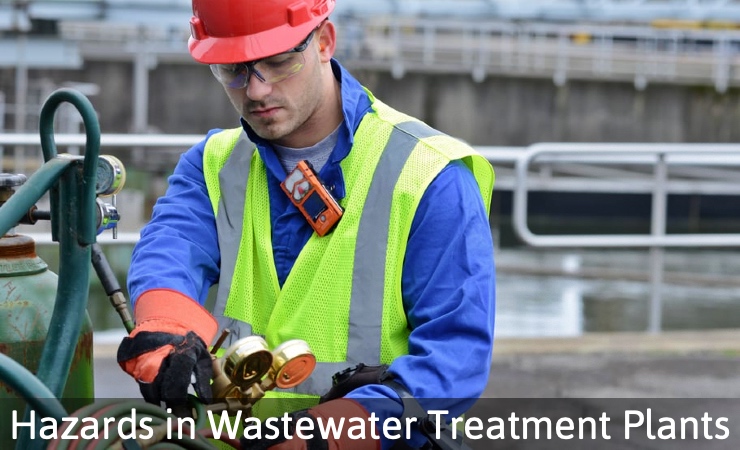
Here we discuss best practices to mitigate hazards in wastewater treatment plants. How best to protect staff from the hidden dangers?
Wastewater treatment plants are critical infrastructure, processing millions of litres of sewage daily from homes and industry. But they also harbour serious hazards for the workers inside.
You likely drive past wastewater plants regularly without a second thought. But for the employees inside, they represent hazardous workplaces filled with unseen threats.
From toxic gases and oxygen deficiency to explosion risks, what dangers lurk within these facilities? And how can you best protect your staff?
Understanding these risks is key to preventing injuries and fatalities and ensuring everyone returns home safely each day.
Recognising the Many Risks
The stench emanating from wastewater facilities provides a hint of the dangers within.
But risks like toxic gases, falls, and confined spaces often go unseen, making awareness and preparation key for safety.
Gases like hydrogen sulfide and methane are byproducts of sewage decomposition and treatment processes. Exposure can lead to asphyxiation, explosion, poisoning, or even death.
Air contaminants aren’t the only risks though. Others include…
- Slips, trips and falls. Concrete floors and metal walkways often have standing water and algae, increasing slip and fall hazards. Ladders, stairways, and scaffolding also pose fall risks.
- Drowning. Workers may be severely injured or even drown if they fall into tanks, pits or other confined spaces containing liquids.
- Confined space hazards. Entry into tanks, pits, digesters, sewer lines or other confined spaces poses dangers of engulfment, entrapment, oxygen deficiency and exposure to toxic atmospheres.
- Chemical exposures. Chlorine, ammonia and other hazardous chemicals used to disinfect and process wastewater can be dangerous in higher concentrations, especially in enclosed, poorly ventilated areas.
- Toxic industrial waste gases. Benzene, hydrogen sulfide, volatile organic compounds and other hazardous substances may enter facilities through sewage pipes from commercial and industrial sources and concentrate in confined spaces.
Gas Hazards in Wastewater Treatment Plants
Toxic and/or flammable gases produced by the wastewater itself or introduced through chemical treatment and industrial waste represent major risks for workers.
Methane and hydrogen sulfide frequently accumulate in hazardous concentrations inside tanks, digesters, lift stations and other confined spaces. They displace oxygen, leading to asphyxiation.
Methane also presents explosion risks at certain levels.
Methane, hydrogen sulfide and oxygen deficiency are the ‘big three’ gas hazards, but there are plenty of other hazards in wastewater treatment plants.
Ammonia, chlorine, chlorine dioxide, and ozone are commonly-used purifying chemicals used to decontaminate wastewater.
These chemicals can reach toxic concentrations if leaks or overfeed occurs, or control systems fail.
Benzene, hydrogen sulfide and VOCs entering wastewater facilities from industrial sources can quickly concentrate in the confined spaces of basins, tunnels and pipes, reaching dangerous levels.

Visit the Entec gas detection team at the Water Conference & Expo, 17-19 October (Stands 109-110).
Steps to Protect Your Staff
It is impossible to fully eliminate gas hazards in wastewater treatment plants. Reliable gas detection in water and wastewater treatment plants is therefore essential to protect workers from danger.
While no single gas detector can account for every scenario, multi-gas detectors such as Ventis Pro, Ventis MX4, and MX6 iBrid are a strong starting point.
Look for durable, intrinsically safe detectors with 4 or more sensors to match your risks – such as LEL, O2, H2S, CO and other toxic gasses.
Proper configuration provides broad coverage from oxygen deficiency and toxicity to explosion hazards. One standard sensor can also be replaced with a specialised option such as chlorine or ammonia for your situation.
But the equipment alone is not sufficient. Here is a brief overview of best practices to mitigate hazards in wastewater treatment plants…
Here are best practices to mitigate hazards in wastewater treatment plants…
- Conduct thorough hazard assessments to identify potential risks. Walk through facilities, note dangers, and establish appropriate controls.
- Provide personal gas detectors to employees entering potentially hazardous areas. Gas detectors should detect oxygen deficiency, toxicity, and flammability risks.
- Ensure workers are trained on proper use and care of gas detectors, including calibration, bump testing, alarm response and more.
- Proper ongoing training is key to ensure detectors are used correctly when lives are on the line.
- Implement strict confined space entry procedures including atmospheric testing and continuous monitoring. Require appropriate ventilation and PPE.
- Eliminate ignition sources such as smoking, spark-producing tools or equipment malfunctions to reduce explosion risks.
- Maintain retrieval equipment and practice rescue drills for various confined spaces. Assign standby personnel.
- Install gas monitoring and alarm systems to alert others if a distressed or downed worker requires assistance or rescue.
- Provide adequate ventilation in workspaces to reduce buildup of hazardous vapours and gases.
Gas hazards remain unavoidable in wastewater plant operations, but with advanced gas detectors in trained hands, workers can be alerted to dangers and take swift action to stay safe.
Effective Gas Monitor Use in Wastewater Treatment Plants
Proper training and adherence to protocols are vital for gas detectors to effectively protect wastewater plant personnel. Key steps include…
- Perform pre-use bump testing to validate that all sensors detect their target gases and trigger alarms. This sanity check verifies functionality.
- Understand cross-sensor interference that may skew readings for certain gas combinations. Consult manufacturer guidance.
- Complete periodic calibration and maintenance per the manufacturer’s recommendations.
- Learn alarm indicators and follow response protocols for evacuation, ventilation, notifying others, etc. React quickly.
- Use intrinsically safe monitors approved for wastewater treatment plants’ hazardous environments. Durability is also important.
- Report any incidents or questionable readings to supervisors to identify potential hazards.
While an indispensable tool, gas detectors require knowledgeable operation to maximise lifesaving potential. With training and vigilance, wastewater crews can rely on their monitors to alert them to rising risks.
Responding to Gas Detection Alarms
Workers must know how to react quickly and appropriately when their gas detector triggers an alarm. Lack of training leads to ignored warnings and danger. Consider these practices…
- If your gas detectors include the ability to provide text-based alarm action messages, then provide clear instructional messages that provide guidance, e.g. “EVACUATE AREA”, “MOVE TO CLEAN AIR”, etc.
- Reinforce training regularly so reaction is automatic when an alarm sounds.
- Activate man down and panic button features if in distress so help can be sent quickly.
- Use monitors with wireless connectivity that can notify others automatically when alarms trigger.
- Accept that detectors cannot prevent all gas exposures. Focus on responding swiftly when alarms sound.
- Ensure functional panic buttons and sufficient gas detectors to enable robust emergency notifications if needed.
- Quick effective response is key to mitigating harm from unseen hazards.
Gas dangers can never be fully avoided in wastewater treatment plants. But by recognising and understanding the risks, implementing training and robust controls, and equipping workers with appropriate gas detection equipment, wastewater plant employees can complete their vital work safely each day and return home to their families.

Visit the Entec gas detection team at the Water Conference & Expo, 17-19 October (Stands 109-110).
Further reading:
- Gas Detection for Wastewater Plants: When Sh*t Hits the Fan
- How many gas detectors do you need to buy? Here’s how to increase efficiency & save money…
- Gas Detector Calibration vs Bump Test – What’s the difference?
For more info on gas detection to mitigate hazards in wastewater treatment plants, here’s what to do…
- Fill out the “Enquire Here” form below
- Ph (06) 262-1280 » (click to call)
- Email us »
- Visit our Contact page »